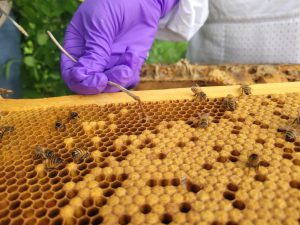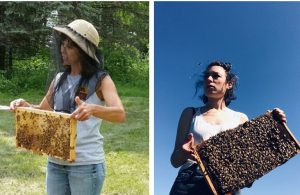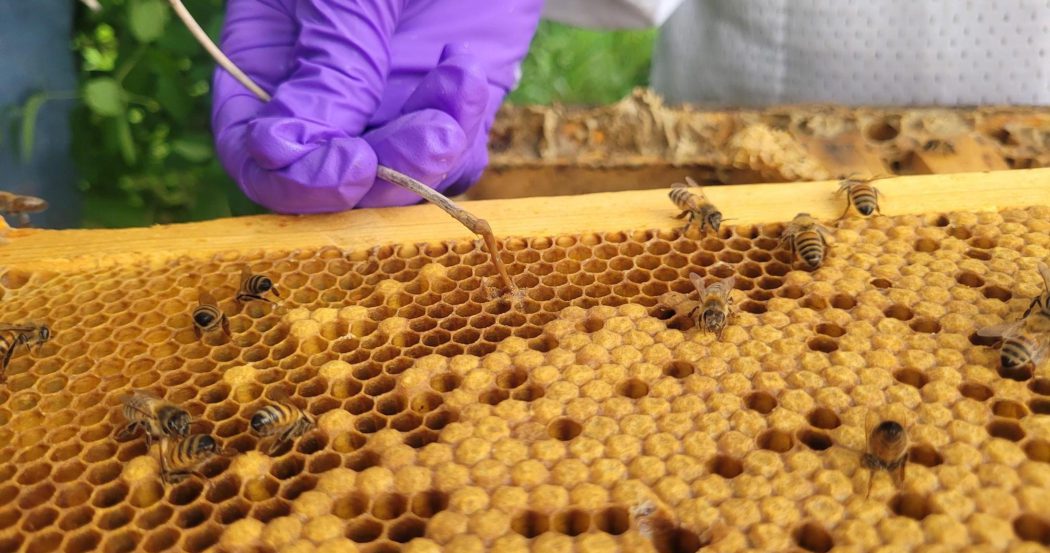Is vaccinating bees in our future?
By: Becky Masterman & Bridget Mendel
Feeling nostalgic for the days when the word “vaccination” was ubiquitous in casual conversation, we decided to explore honey bee vaccinations by interviewing Annette Kleiser, Ph.D., CEO for the biotech company Dalan Animal Health, which has been granted a conditional license by the USDA for their honey bee vaccine.
If you thought creating a vaccination for a regular body was complicated, try making one for a superorganism! In the case of the vaccine Dalan is developing, every mated adult queen would need to be vaccinated. And right now, they are just working on American Foulbrood (AFB), which, while an outbreak can devastate, remains a less-common concern than other diseases like European Foulbrood (EFB), deformed wing virus, chalkbrood and others. How many beekeepers would think it worth preventively vaccinating against this awful but less common disease, especially if they requeen – and would therefore need to revaccinate – yearly?

Figure 1. The field diagnostic test for AFB is to measure the ropiness of the diseased brood. Photo credit: Heather Chapman
We reached out to Annette to find out more. And she assured us that they were truly in the proof-of-concept phase, with the primary goal of garnering support and interest in the beekeeping world. But we had to wonder, why start with a disease so virulent that challenging bees with it to see if the vaccine worked would be… problematic?
Beekeepers are used to industry pressing technology on them, and most of us have developed a somewhat skeptical stance towards the myriad of supplements, gadgets, and flow hives that are foisted upon us, so we brought that attitude to Annette right away. What was her investment in the beekeeping industry?
First of all, we thought Annette was very cool. She is a biologist by training, then moved to helping researchers to develop products and take their work beyond publications. Annette had done her homework and shared a sentiment that spoke to us: “Honey bees… play a vital role in our food security, mitigating climate concerns and supporting biodiversity. ⅓ of our foods depend on pollination, and honey and other products are critical in our food and pharma industries. Despite this fact, beekeeping has been overlooked too long by traditional animal health to provide modern tools for disease prevention and management. Dalan’s goal is to change this.”
We were on board with their goal of finding solutions to bee diseases that don’t rely on antibiotics or equipment-fed bonfires. As you’ll see in the Q&A, Dalan, like beekeepers, doesn’t believe in silver bullets and instead sees their vaccine as a tool in the larger toolkit of good management, good hygiene, good genetics and good nutrition. After we share her answers to our nosy questions, we will end with some further thoughts and questions that were left pondering…
Q: Talk about honey bee immune response and how it relates to the vaccine.
A: Transgenerational immune priming (TGIP) is a natural process whereby maternal insects protect the next generation of offspring from diseases. Nurse bees will encounter a pathogen in the hive, by let’s say cleaning out larvae that have come down with AFB. The nurse bee will take up some of the bacteria that cause the disease, and some bacteria may end up in the royal jelly that is fed to the queen. When that happens, pieces of the dead bug will end up in the ovaries and stimulate an immune response in the developing larvae making them more resistant to infection once they hatch. Our vaccine builds on this natural process. During the vaccination process, we expose the nurse bees and the queen in a very controlled way to a high dose of dead bacteria to ensure that the correct amount is transported to the eggs.
Q: Currently beekeepers are warned about potential AFB transmission from used equipment or feeding their bees honey from unknown sources. Do you see this vaccine as a game changer for the need of those practices?
A: AFB is so problematic because spores can live in the environment for decades, but other bacteria and diseases can be contracted from the use of honey and other sources. I think caution and good hygienic practices should always be part of the routine to keep colonies safe. However, we see this vaccine as a critical part of an integrated control program for sustainable beekeeping that for too long has relied solely on antibiotics to fend off bacterial diseases.
Q: Hygienic behavior has been helpful to remove AFB infected brood from the colony nest prior to it becoming infectious. Has anybody investigated or discussed the potential efficacy of the vaccine and hygienic behavior in protecting bees from AFB?
A: Honey bees are often called a superorganism where the colony has mechanisms for dealing with diseases and infection on an individual level, and on a colony level. Individually bees neutralize disease-causing agents, through a variety of mechanisms like the cutis, grooming, saliva, antimicrobial peptides and other components of the bee immune system. On the colony level, the disease is eliminated though hygienic behavior, removing sick larvae, food sterilization, propolis, but also increasing the colony temperature and creating a fever or sharing antimicrobial peptides with each other. Our vaccine has to be seen in this context. Vaccination is supercharging TGIP and will be supported by all other superorganism mechanisms of disease prevention. Dalan is currently conducting a multi-year, large scale pilot field trial to study the effect of vaccination in the field, where all is coming together.
Q: Does the current research support the possibility that one vaccine might be able to protect bees from multiple pathogens?
A: Our researchers started looking into this for bacterial brood diseases. We have encouraging early results but that is as much as I can say at this time.
Q: The idea of a bee vaccine is exciting, but beekeepers know to be suspect of things that look like silver bullets. What warnings do you have about the capacities and efficacy of this vaccine?
A: I don’t think there is such a thing as a silver bullet. We still need to provide skilled care for these precious animals. Our vaccine was tested and licensed for one disease. It is the first step towards a new era of disease prevention in honey bees. One day we want these tools to become part of the routine measures to protect honey bees, just like taking our pets to the vet to make sure they are protected and kept safe and ensure that they don’t spread diseases to others.
Q: Are there common misconceptions you would like to address?
A: One of the most common misconceptions is around efficacy. When we develop animal vaccines, and in particular, when working with highly contagious diseases, we had to conduct lab efficacy tests rather than infecting animals in the field. That requires establishing laboratory models that use an extremely high infection pressure forcing a high number of animals to die. This is important to arrive at a statistically significant efficacy result. We infect larvae with 5,000-10,000 spores, while typically less than 200 spores are sufficient to kill larvae in a hive. However, we achieved up to 50% survival in these extreme situations in the lab. If you now think of the field situation where you have a much lower infection pressure in the early stages, plus you add in the superorganism ability for disease mitigation, the assumption is that efficacy of the vaccine to protect from disease will be a lot higher.
Q: The Dalan pipeline has AFB, EFB and chalkbrood. Are the viruses transmitted by V. destructor on your radar?
A: Yes, viruses are very important and tools to protect from them need to be a key part of mite management. Viral vaccines are more difficult to manufacture but now that we know how to develop bee vaccines in general, we are ready to tackle viruses as well.
Q: What else do you want to share with us?
A: We realize that our product is just the start. We must be mindful that modern agriculture must also act responsibly in the use of insecticides and herbicides, and that we are at a tipping point. Our product has to be a part of a concerted/integrated effort to provide bees the best possible environment for them to do their job. This may require not only voluntary reductions in some of the damaging chemical practices, but also potential legislation.

Becky Masterman led the UMN Bee Squad from 2013-2019. Bridget Mendel joined the Bee Squad in 2013 and has led the program since 2020. Photos of Becky (left) and Bridget (right) looking for their respective hives. If you would like to contact the authors with your bee vaccine thoughts, please send an email to mindingyourbeesandcues@gmail.com.
Concluding thoughts:
We felt that Dalan’s desire to gather feedback from experts – beekeepers – was sincere: because vaccinating individual bees seems time consuming, the product would need to be excellent enough to actually save the beekeeper money and labor towards honey bee disease management.
While efficient and effective vaccination still seems a long way off after this interview, we like the mindset that we need to prevent disease as much for our bees as for our neighbor’s bees. If varroa and their virus complex has taught us anything, it is the imperative for this community-minded approach. We like Dalan Animal Health’s investment in the vaccine technology, though beekeeper investment is also needed to move this solution forward. Meanwhile, we can dream of a double disease vaccination that protects against the less common AFB and currently too common and menacing EFB. We would give it a shot!
Resources
Dalan Animal Health https://www.dalan.com/
About American and European Foulbrood https://bee-health.extension.org/american-and-european-foulbrood/









